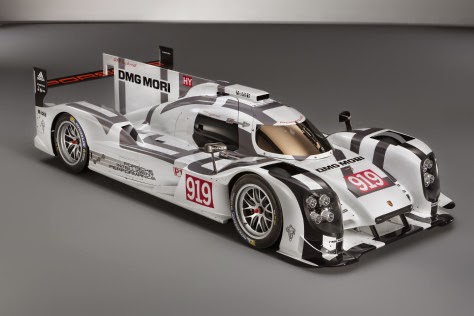This is the new Porsche 919 Hybrid, and it signals Porsche’s return to the world famous Le Mans 24-hour endurance race after an absence of 16 years. The 919 Hybrid was unveiled this morning at the 2014 Geneva motor show – and a switch from Red Bull Racing to Porsche means this is also Mark Webber’s new company car.
Porsche 919 Hybrid? So what’s the engine in the new Porsche race car?
You’d be safe taking a punt and guessing it’s not a diesel engine like arch-rivals Audi, but it’s not a naturally aspirated V8 petrol like the one that’ll feature in the new Toyota TS040 either. It’s not a flat-six either. No, the engine that powers the new Porsche 919 Hybrid is a turbocharged 2.0-litre V4. Yes, this is a four-cylinder Porsche race car…
Err… why?
Because new-for-214 rules for the Le Mans 24hrs – and the wider World Endurance Championship, of which the famous French race is now the marquee round – focus on energy consumption per lap. There are no engine regulations (hence the three different layouts used by Porsche, Audi and Toyota) but this year the amount of fuel that can be used each lap has been cut by around 30%.
Correspondingly, the amount of power that can come from the (mandatory) hybrid systems has increased dramatically. So Porsche (and Audi and Toyota) have each picked the solution they think will prove most fuel efficient – and fastest.
What else do we know about the Porsche 919 Hybrid?
That the racing won’t be slow. While the new Formula 1 regulations have a fuel limit per race, and thus Vettel and co won’t be running at maximum attack throughout, the LMP-H racers will be optimised to make the most of their fuel allowance per lap, and therefore be flat-out.
As for the powertrain, the innovative V4 engine revs to around 9000rpm, and its boosted by two hybrid systems, one using regenerative braking on the front axle, and the other using recovery of thermal energy from the exhaust gases. Both systems then feed into a single electric motor powering the front wheels (with the petrol engine driving the rear axle) and despite the electrified gubbins, a carbon monocoque helps the 919 weigh just 870kg.
The 2014 WEC season starts on April 20 at Silverstone, with Le Mans the third round of the championship on 14-15 June. And it’s not just the car that will be the star, as ex-Red Bull F1 driver (and long-time Porsche enthusiast) Mark Webber will be one of the six drivers competing in the two 919s that are being entered.
Did Porsche unveil anything else at the Geneva motor show?
Another track star. Besides the 919 Hybrid was the 2014 iteration of the 911 RSR race car, which won the GT category at Le Mans in 2013. For the new season double wishbones replace the road car-derived MacPherson strut front suspension, there’s a new six-speed paddle-shift gearbox too and detail revisions to the 470bhp 4.0-litre flat-six.
Plus more carbonfibre parts lower the centre of gravity, improve the weight distribution and cut weight, and those carbon body parts are also more aerodynamically efficient and feature a new ‘quick-change concept’ so they’re easier to replace in the pits after an on-track incident.

